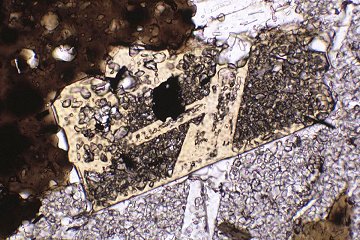Nucleation and overstepping in prograde metamorphic reactions
This abstract is from a presentation at a conference on textures in metamorphic rocks in Manchester, 1990.
Nucleation and overstepping in prograde metamorphic reactions: implications for overall reaction rates and crystal size distributions.
D.J. Waters
Dept of Earth Sciences, University of Oxford, Parks Road, Oxford OX1 3PR.
Nucleation theory suggests that the rate of heterogeneous nucleation of a new phase should show a very sharp dependence on the amount by which the equilibrium temperature for a metamorphic reaction is overstepped, so that nucleation begins suddenly after a certain critical overstep is achieved.
The interaction between nucleation rate and mineral growth rate (interface- or diffusion-controlled) may take two forms, depending on the rate of heat supply. At low heating rate, mineral growth rates are rapid relative to heat supply when the critical overstep is reached, so that crystals appear only at the most favourable nucleation sites, and reaction runs to completion over a small T (temperature) interval. At a high rate of heat supply, mineral growth cannot keep pace with T increase, and abundant nuclei form over a wide interval of T and site energy. A natural experiment in the aureole of the Bushveld Complex, South Africa, using the calculated heating rate at the transition between porphyroblastic and granoblastic-textured cordierite-andalusite hornfelses, suggested a critical overstep for andalusite growth of around 10°C, and a somewhat smaller overstep for cordierite (Waters, 1989, Terra Abstracts 1: 297). Crystal numbers in porphyroblastic rocks are consistent with the suggestion that when ranked in terms of critical overstep, minerals form the same sequence as the crystalloblastic series.
The sharp sensitivity of nucleation rate to overstepping also suggests that crystal size distributions primarily reflect changes in the nucleation rate with time. Natural size distributions are of two types: exponential, in which the majority of grains are concentrated in smaller size fractions, and unimodal, in which small grains are under-represented. Exponential size distributions, reflecting a continued increase in the nucleation rate with time, are found in hornfelses, while unimodal distributions seem typical of regionally metamorphosed rocks. A number of factors may lead to a decrease in the rate of nucleation with time, and hence to a unimodal size distribution:
- a reduction in the availability of favourable nucleation sites.
- a fall in temperature, perhaps due to reaction enthalpy extracted from the reacting volume.
- multivariant reaction, taking place over a significant T interval.
Computer simulations of nucleation and growth show that the third factor is highly influential, and that this, rather than Ostwald ripening (Cashman and Ferry, 1988), is the most probable reason for the prevalence of unimodal grain size distributions in regionally-metamorphosed rocks.
With multivariant reaction, overstepping is a function of both temperature and reaction progress. In the case of garnet, the combination of multivariant reaction and a large critical overstep provides a potential explanation for size distributions and chemical zonation patterns in low and medium grade rocks. Initial garnet growth occurs rapidly at temperatures near the critical overstep. The first garnet is strongly out of equilibrium, and may not record systematic Fe-Mg partition between garnet rims and matrix phases. Instead, the zonation may be dominated by fractionation of minor elements such as Mn and Ca. Garnets grown near the garnet isograd are likely to be dominated by this growth pattern. The nucleation rate declines as progress of the garnet-forming reaction reduces the amount of overstep. Subsequent growth is slow, takes place closer to equilibrium, and keeps pace with gradual temperature increase, allowing growth zonation to record shifting Fe-Mg(-Mn) continuous equilibrium.
Created 16 September 1996

